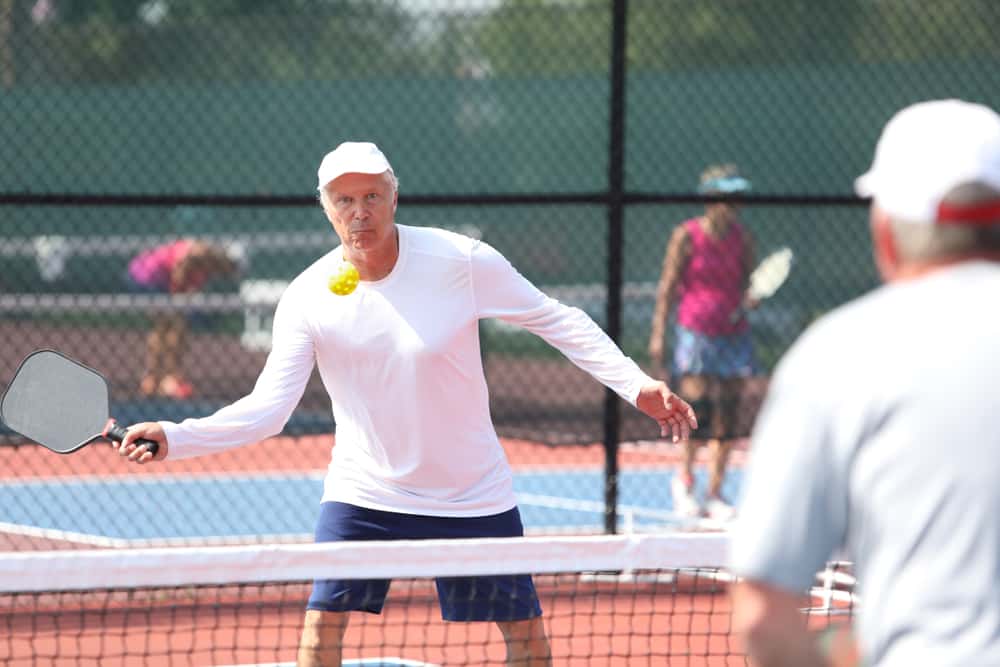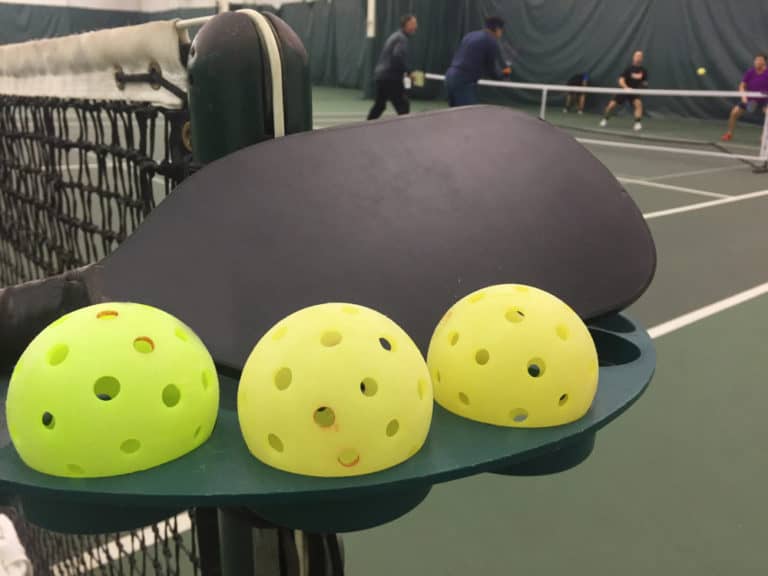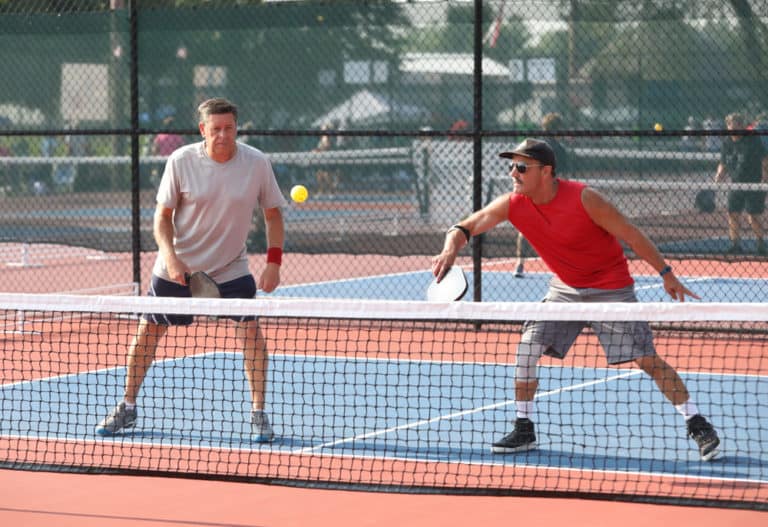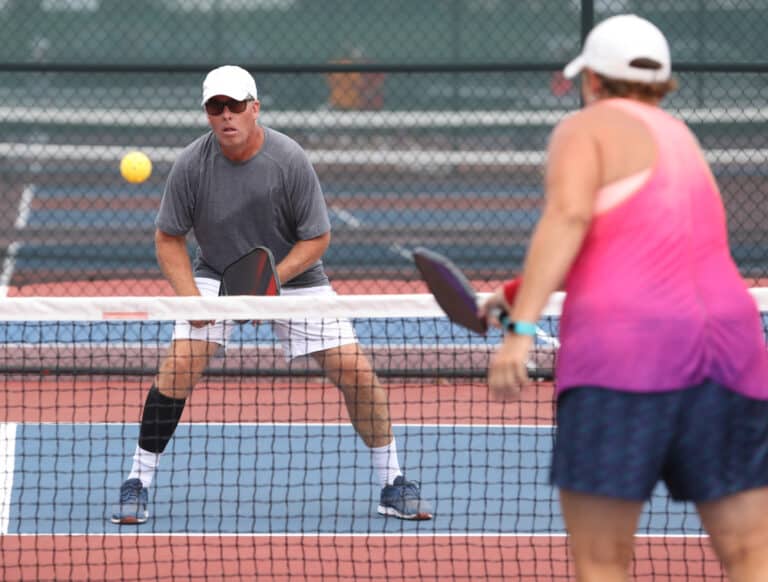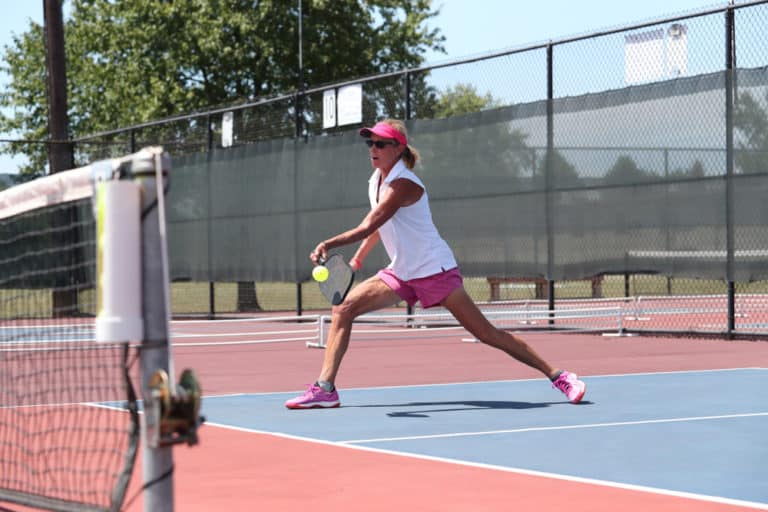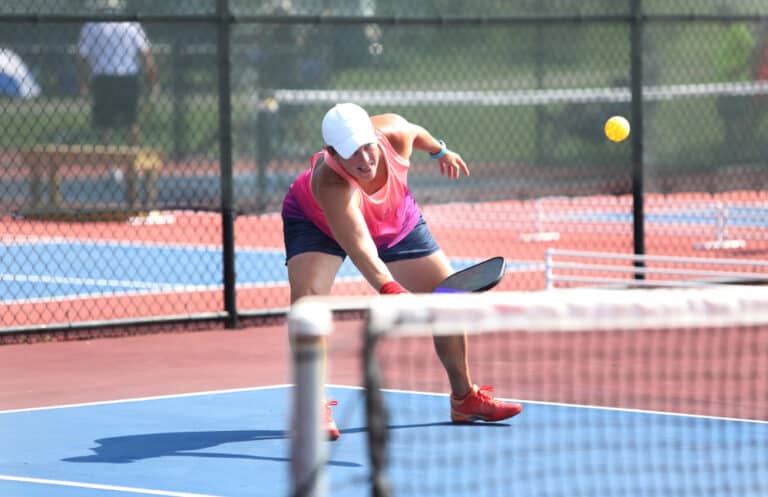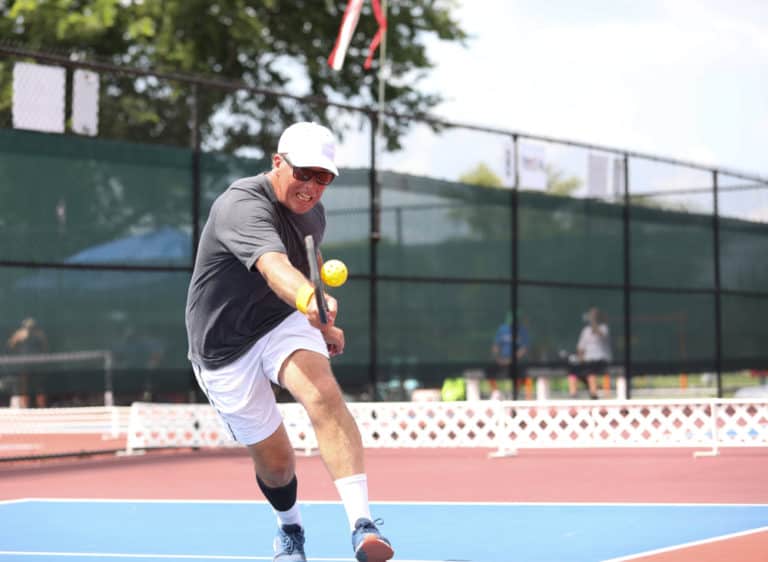What Is A Dink In Pickle Ball?
Pickleball is the fastest growing state sport in the US with nearly 5 million players. The popularity of this game is spreading worldwide. It’s not an Olympic, para-Olympic, or a world title game but demands skill and strategy. So what’s a dink in pickleball?
A dink is a softer shot used to control a pickleball game. The dink neutralizes fast playing and rallying shots from the baselines. The dink moves the game closer to the net and into an opponent’s non-volley zone (NVZ) or kitchen. This shot stops an opponent from smashing a ball back.
A good dink is played low over the net and drops quickly to land in the kitchen. It’s not a high or a deep shot, but one played close to an opponent’s non-volley line. A dink shot’s angle matters as much as the low force with which the shot is played. The aim is to slow the game down. Just how to do this shot and also be a ninja drinker takes skill and practice. Let’s see how it’s done.
A Dink In Pickle Ball
As the 1960s kids’ backyard game gathers momentum, enthusiasts – old and young, of all degrees of fitness, shapes, and sizes – battle it out on the edge of the non-volley zone. Playing the dink shots demands fitness; even agility and balance are needed to bat and land a dink pickleball in the kitchen – not in your home!
The dink shots are part of Pickle Ball – a game with early influences from Badmington, table tennis, and even tennis. The size of a Pickle Ball court is that of a Badminton one, which is a third of a tennis court. The net is 3 feet high, not a Badmington’s 5 feet raized net. The paddles are solid and larger than those used in table tennis.
The differences are the perforated and hollow polymer ball, and on the court, there’s the non-volley zone or NVZ. The NVZ doesn’t exist in Badmington where being against the net is a prized position to reach up and smash down a shuttlecock into opponents’ territory to score a point. In tennis, smashing a high ball from close to the net down to land on an opponent’s court is exciting.
A Dink Shot in Pickle Ball
A dink ball is a strategic hit that takes practice to gain points from opponents. In Pickle Ball, a dink is a shot played with the intent to score. Getting a dink shot right is a point-scoring technique. Pickle Ball works on a side-out scoring method, meaning that the serving side scores a point when the non-serving team defaults.
A dink pickleball must drop in the area between the net and the non-volley line – a 7 feet wide space on either side of the net. The space between the net and the non-volley line is known as the non-volley zone (NVZ). Players are not allowed to stand in this area.
On the court, each side is divided by the net into the 7 feet deep by 20 feet wide non-volley zone and an area between the non-volley line and the court’s baseline of 15 feet by 20 feet wide. The NVZ is not a zone in Badmington or tennis, and in Pickle Ball, it’s known as the kitchen.
The dink shot played within the rules of Pickle Ball brings the game to the edge of the non-volley line – neither of the sides must enter this zone. And if a short dink shot lands and bounces there, the player can just for the return step inside the kitchen. Play the ball back. And then has to immediately step out again.
Dink As Softer Shot
The dink shot is a softer ball to gain control of a Pickle Ball game. The aim of playing a dink is to catch an opponent off-guard. The dink is played as a low and short ball over the net and into the kitchen. The aim is to keep the dink low to stop an opponent from getting the upper hand and smashing the high bouncing or high pickleball back.
Coaches say that the dink shot is not a pickleball that’s hit to cause trouble for your opponents. But it is a shot that stops them from smashing down a high ball so you lose a score. Playing close to the net, shortening the play from the baselines by almost two-thirds, changes the game. This is why the dink is seen as a game-changing shot.
The best way to describe a dink or dink shot is to consider it neutralizing. The shot is hit with a soft paddle stroke. The shot must be low over the net. The pickleball needs to land in the opponent’s non-volley zone. The opposing team needs to be drawn towards the non-volley line on their side of the court.
The dink is played to keep you out of trouble, which simply means putting you in a better position to score. Playing and rallying a pickleball fast over the net can be unnerving, especially if you’re fending off high balls smashing down at you. We all experience that feeling when our only choice is to side-step and miss the opportunity to return the pickleball.
Play A Dink On The Edge Of A Kitchen
You’re playing for fun, but you also want to play to score. You know the score. You have to know just how to do that. And, you can gain in the game by learning how to dink. Or better still, learn to play pickleball as a series of dink shots. Unlike tennis or badminton, as shown above, and despite some resemblances, you can’t enter the no-volley zone in Pickle Ball.
In Pickle Ball, you can’t play close up to the net. But you can play from a position just outside the NVZ, even right up to the non-volley line. You have a 7 feet (by 20 feet) space on your side and 7 feet by also 20 feet wide on your opponent’s side to plan a dink and land the pickleball.
Bringing the Pickle Ball game right close to the net changes the game from one customarily played from the outer baselines of the court.
Shifting Pickle Ball From The Baseline To Net
Playing Pickle Ball from the baselines demands longer and stronger shots. But bringing the game closer to the net is when the dink shot is the winning one. This shot is not called a neutralizing one for no reason. The dink is a strategic shot. Hitting a dink shot demands that you change your playing posture, how you hold the paddle, and your swing to hit the pickleball.
Close to the net, a player’s stance changes to a much lower one. Drinkers who play well are known to play with their knees bent and almost as low as the court’s level. Most of the hitting with the paddle happens in front of the body. There is no full-out back solid swing. This will hit the pickleball too hard and even off the court.
The dink shot slows down the game and forces opponents to play differently. From the baselines, players have strong and hard shots played over the 44 feet length of the court (and a diagonal line of 48 feet). With dinks, the game is played in the two non-volley zones. These kitchen areas are 7 feet deep and 20 feet wide.
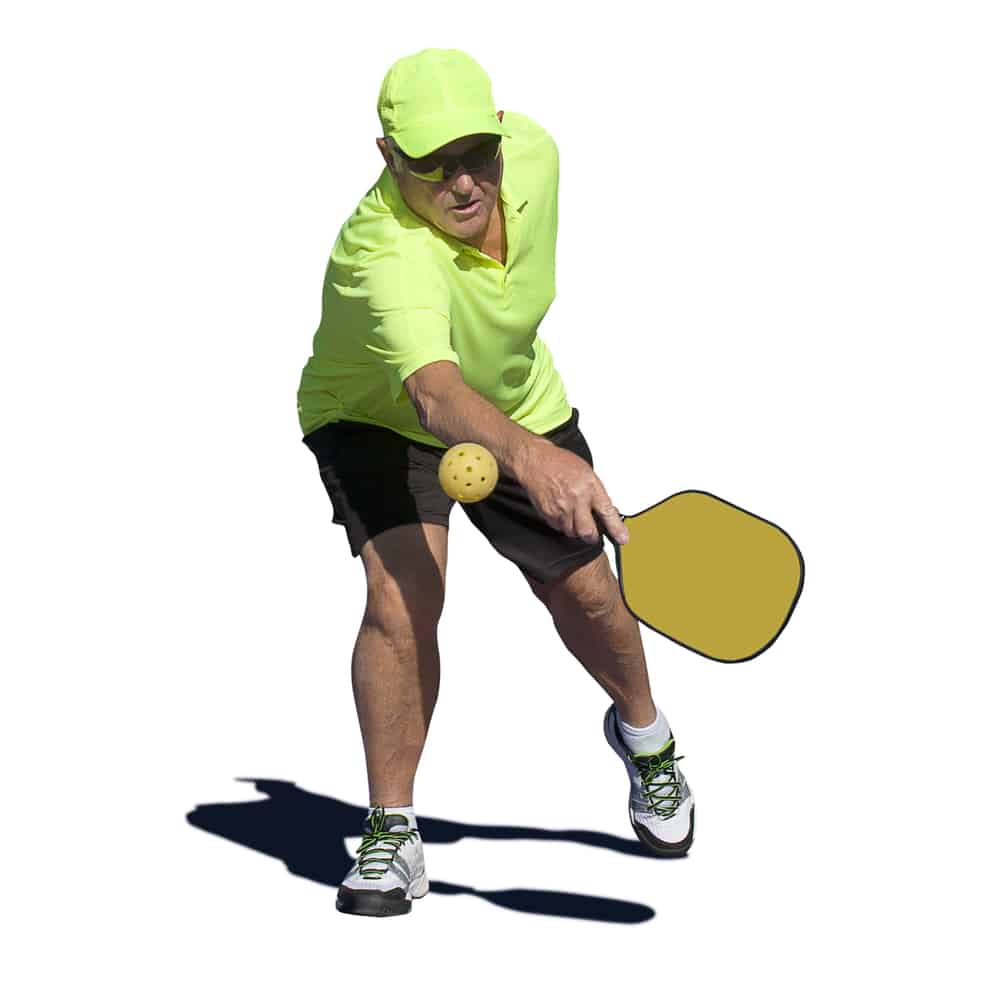
Playing Pickle Ball Dink Shots
The dink shot is simply one that you use to change the direction of play. As seen above, there are moments when the long stretches of hard-hitting and rallying need to be changed. Mainly if the game is develop into hard shots – fast rallying from the court’s baselines, and nothing more.
Of course, the Pickle Ball game covers the whole court but there are moments in which you strategically change the game. The change happens on the return ball. If you’re hitting a dink or dink shot, the return is soft, mainly from the edge, near or at the non-volley line. Such a change brings the players closer to the net – an exciting and challenging position.
Two kinds of dink can be played:
- The dink shot
- The dink volley
The dink shot (as discussed above) is a soft return that clears the net and drops down in the opponent’s non-volley zone. The shot is played to where the opponent is standing, or it can be hit in a diagonal direction (left or right on the kitchen’s center).
With the dink volley, this pickleball is returned from a position at or near the non-volley line. The pickleball is hit back before it bounces. This shot is hit from outside the kitchen area. And the best return dink volley clears the net and is hit soft enough to drop down in the opponent’s non-volley zone. The aim is to drop the pickleball low to stop an opponent from smashing it back.
These shots are to outmaneuver opponents. The aim is to get opponents off-guard by moving the field of play away from the baselines to the edge of the non-volley line. The main reason, of course, is to use the dink shot for scoring. The dink shot slows down the game, and is offensive and strategic – you want to gain points from this move.
Control Opponents Return Shots And Score
The dink shot doesn’t end once the ball leaves your paddle. But the way you play a dink, how low over the net it moves, and how slow and where it drops in the non-volley zone is crucial to score. The drop of the ball (and bounce up) challenges the opponent.
The bounce affects the kind of return shot that’s played. This can mean that a pickleball is returned and hit against the net. Or it can be lopped high into the air, making it easy for opponents to reach up and smash the pickleball down on the other side.
What a dink does is it forces a specific kind of play. The unexpected change in play draws the players to the non-volley line. And once the dink happens here, there’s the trajectory or angle of the pickleball that’ll influence the return shots.
The height at which the pickleball crosses the net, and the downward drop, influence the return angle. Dink shots can be played on the diagonal within the kitchen and not just playing directly across to and fro. The pickleball players on either side of the kitchen (the non-volley zone) must not cross the edge of the non-volley line.
Strategy And Hitting A Dink Ball
There’s definitely something like a good dink shot and it’s not just hitting a softer shot and getting it low over the net. Where a dink lands is crucial. The best position is closest to the opponent’s on-volley line. Landing a dink on the center of this non-volley line is best as this puts up tension between two players in doubles over who returns the ball.
Some strategic or thought-out dinks will:
- Force an opponent to return the pickleball by hitting it upwards and back over the net
- This will allow returning the pickleball with a fast smash
What pickleball players agree on is that the dink shot sets the pace of the game – each dink controls the speed of the ball. You learn to hit block shots shorter with a less defined backswing. A strong backswing puts more force on the pickle ball’s flight. By blocking shots, a soft block, the flight of the pickleball is slowed down.
The dink shot takes the place of a back swing and force, and in the dink shot, it is essential to keep one’s wrist still when playing.
There are options for where you play the dink, such as:
- Directly opposite and to the opponent
- Diagonally across in the kitchen or non-volley zone
The advantages of playing a dink shot involve how these are placed. You need to consider the length and height of the dink. And remember, this is a shorter shot when you play directly opposite an opponent. You want to avoid an opponent smashing the pickleball back at you. That is why the height of a dink shot is essential.
Tips To Hit A Dink
A dink has technical aspects that have to do with where but actually how you stand. Your paddle control, wrist grip, and swing also are essential. So when you’re out there practicing, note the following:
- Play a dink shot with your paddle in front of you between your body and the net (a solid position to hit from and control the ball)
- Avoid a full swing that starts behind or even beside you
- You need little or no back swing – the longer the swing, the faster the pickleball will travel (you don’t need speed in the kitchen area)
The way you stand when playing a dink shot is crucial. The best is settling your balance, either with both your feet facing the net (a neutral stance) or both feet facing one side of the court. And remember, as coaches say: you’re not waiting for an elevator! Your opponents are ready to pounce, so surprise them with a dink!
Conclusion
Become the dink ninja you’ve dreamt of being. Make your mark on the pickleball court. Get out there and practice, even against a wall. A dink or dink shot cuts down on unnerving rallies. Playing that dink is fun to master and will get you the score you want.
A good dink lets a pickleball player take control of the game – learn to hit slow and low over the net. Land the pickleball to challenge your opponent to either hit into the net or return a high ball that you can slam back and score a point.
References
- https://www.youtube.com/watch?v=VDtNk8JjDO0
- https://www.youtube.com/watch?v=SXW0PK8VgJg
- https://en.wikipedia.org/wiki/Pickleball
- https://en.wikipedia.org/wiki/Score_(sport)#Scoring_by_sport
- https://en.wikipedia.org/wiki/Glossary_of_pickleball_terms#D
- https://www.nytimes.com/2022/09/03/well/move/pickleball-popular-sport.html
- https://www.nytimes.com/2022/08/20/health/pickleball-sports-injury.html

